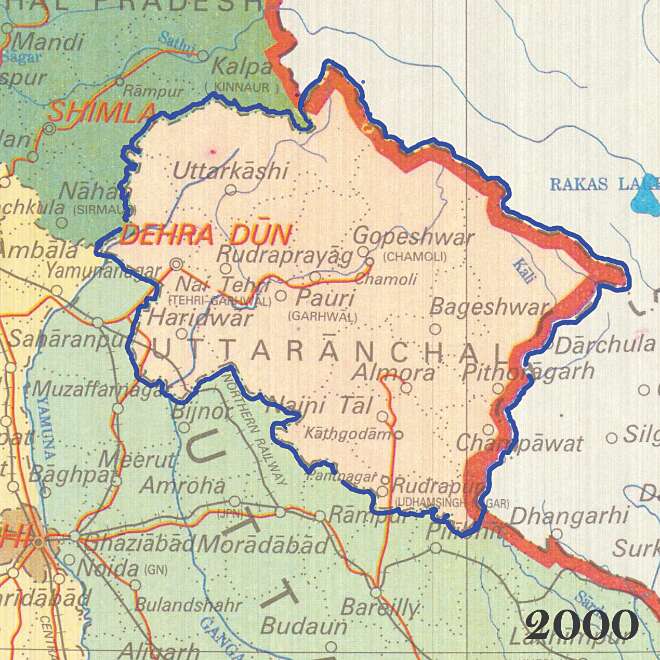Upsurge against exploitation
The demand for preservation of traditional rights over forest resources in the colonial period transpired into that for a separate administrative unit during independence

Before the Gurkhas established their rule in 1790, the Garhwal and Kumaun regions were ruled by the Parmar/Panwar and Chand dynasties respectively. After the Anglo-Gurkha war of 1815, the Treaty of Sugauli allowed Sudarshan Shah to rule over Tehri Garhwal, while Pauri Garhwal and Kumaun were brought under the Governor-General — who administered it as a Non- Regulation Area — by the Commissioner of Kumaun who was more powerful than any other commissioner in the United Province. He had both executive and judicial powers, and he also acted until 1937 as the British agent to the Tehri principality. It was then placed under the Punjab Hill States Agency, and later under the Ministry of States. Between 1815 and 1947, Kumaun had some legendary commissioners, and the tenures of GW Trail (1816-36), Henry Ramsay (1856-84), and Percy Wyndham (1913-24) are remembered in local folklore as well.
However, by 1864, the operational 'power' in the hills started shifting to the Forest Department. In 1868, the management of the forests of Kumaun was handed over to this department. The Indian Forest Act of 1878 outlined a process, whereby the State could take over forest areas for its exclusive use. This has to be seen in the context of the great railway expansion project by the colonial empire, especially, after the Crown took direct control of the administration. The objective was to ensure the movement of men and materials across the length and breadth of the sub-continent. Even in the administrative headquarters of Kumaun, the forest around the town of Nainital was demarcated and declared 'protected'.
The kingdom of Tehri Garhwal followed the British example even more brazenly for there was money to be made from 'wooden sleepers' and the income from forest was the mainstay of revenue of the Tehri raj. Tehri was also home to Frederick Wilson, who began collecting the pelts of animals and stuffing the skins of the monal pheasant, rare white tigers, black and brown bears, and the musk deer for commercial profit. Later, he used his extensive knowledge to provide a major chunk of the two million sleepers requisitioned to the railways.
However, all this meant that the peasants, artisans and craftsmen who lived in the vicinity of the forest lost their traditional sources of livelihood. The boundaries of the reserved forest now extended right up to their fields and houses. Forest exploitation was proceeding apace even as villagers were no longer allowed to practice shifting cultivation. The consequence of all this was sporadic 'dhandaks' (protests) under the leadership of Badri Singh Aswal and Lachham Singh Kathait. The prominent nationalist leader G B Pant drew up a detailed chart to show the reality of this "resource kidnap" between 1897 and 1916. The First World War intensified the demand for timber and 4,00,000 sleepers were sent out of Kumaun, but by this time, the peasants rose to revolt against the restrictions on their traditional and customary rights. The other irksome
issue was the institutionalised system of begar (work without remuneration) for the visiting officials of the forest and revenue departments.
In 1916, with the formation of the Kumaun Parishad and a clear position taken by the local press, protests began to take shape of an organized movement. Forest issues had merged with the strife against begar. The merger had lent depth to the struggle. In various gatherings, the abolition of begar and the restoration of forest rights were permanent demands presented repeatedly. On May 11, 1919, a gathering chaired by Hargovind Pant in the Nandadevi Prangan (temple compound) of Almora demanded the abolition of Begar and the restoration of full rights over forests.
In 1921, a Kumaun Forest Grievances Committee (KFGC) was constituted to understand the problems relating to forest land. To a large extent, this committee restored the forest rights of local farmers. While valuable forest areas remained with the state, villagers were encouraged to manage the areas close to their settlements – those designated as "van panchayats". By the time of independence, there were close to 500 van panchayats in the Kumaun Division.
Meanwhile, in 1938, the Congress party held a conference at Srinagar in Garhwal and raised the issues pertaining to both Kumaun and Tehri. Jawaharlal Nehru participated in this conference held under the presidency of Pratap Singh Negi. Nehru agreed that the people in these hills had the right to take their own decisions and enrich their culture in view of their peculiar circumstances. Later in 1939, the Congress, in its political meet at Pauri, witnessed the emergence of 'Garhwal Jagrit Sanstha' which comprised those Congressmen (like Pratap Singh Negi) who were not satisfied with the progress in regard to the demands of the hill people. In Kumaun, in the meanwhile, leaders like Badri Dutt Pandey (Kumaun Kesari) and Puran Chand Tiwari demanded a separate administrative unit for the hills in a meeting held in 1946 at Haldwani. Later, Badri Dutt Pande sent this demand for consideration to the States Reorganization Commission.
Meanwhile, the popular protest movements in Tehri were also gaining strength, and even though the maharaja had banned all political activities in his state, the Rawain and the Saklana revolts over forest restrictions and cess on potatoes, and the resistance to Pontoti tax (customs duty) were the precursors to the freedom movement of princely Garhwal. Chandra Singh Bhandari's refusal to open fire on his fellow Indians at the Peshawar cantonment symbolized the Garhwali resistance and made him a legendary figure who inspired Garhwali youth against both feudal and British oppression. Meanwhile, Praja Parishad came up in Dehradun and leaders like Sridev Suman, Paripurnananda Penyuili and Virendra Datt Saklani fought for fundamental political and economic rights of the people of Tehri. (....to be continued)
The writer is the Director of LBSNAA and Honorary Curator, Valley of Words: Literature and Arts Festival, Dehradun
Views expressed are personal



